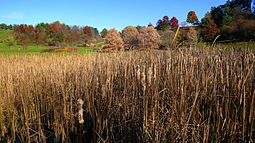Cornell Botanic Gardens
| Cornell Botanic Gardens | |
|---|---|

F. R. Newman Arboretum in the Botanic Gardens
|
|
| Location | Ithaca, New York, United States |
| Area | 4,300 acres (1,700 ha) |
| Established | 1875 |
The Cornell Botanic Gardens, formerly known as the Cornell Plantations, is a botanical garden located adjacent to the Cornell University campus in Ithaca, New York. The Botanic Gardens proper consist of 25 acres (10 ha) of botanical gardens and 150 acres (61 ha) of the F.R. Newman Arboretum. The greater Botanic Gardens includes 40 different nature areas around Cornell and Ithaca, covering 4,300 acres (1,700 ha).
The origin of the Botanic Gardens dates back to Cornell's beginning in the mid-19th century and are part of the university's longtime interest in agriculture, forestry, and the natural sciences. The Botanic Gardens saw a major planting effort during the 1930s and assumed their present name in 1944. Gardens and facilities have continually expanded, including a construction program at the start of the 21st century. The Botanic Gardens also maintains four gardens on Cornell's central campus. The Botanic Gardens offers three courses for academic credit, are used as a resource by other classes, host a number of informal lectures and tours, and have played a part in many scholarly papers. As of 2009[update], the Botanic Gardens had a $2.9 million annual operating budget.
The gardens specialize in trees and shrubs native to New York State. The themed herb garden is especially noted. The Botanic Gardens have been the subject of several books and films over the years, are open daily without charge, and have been recommended as a visitation site by a number of travel books and newspaper travel sections.
Prior to the founding of Cornell University, Ezra Cornell had a large farm on the East Hill above Ithaca, New York. As part of locating New York State's land-grant college in Ithaca, Cornell offered to donate the farm for use as a campus. In 1862, Cornell's first president, Andrew Dickson White, wrote a colleague that a great university should include a botanical garden: “It must have the best of Libraries – collections in different departments – Laboratory – Observatory – Botanical Garden perhaps…” At the university's opening ceremony in 1868, Louis Agassiz, an internationally known naturalist, remarked that no other area could compete with Cornell's surroundings in the opportunities offered for the study of natural history. From its inception, Cornell formed a reputation for creative means of research into the natural sciences, including the establishment of the pioneering College of Agriculture.
...
Wikipedia
